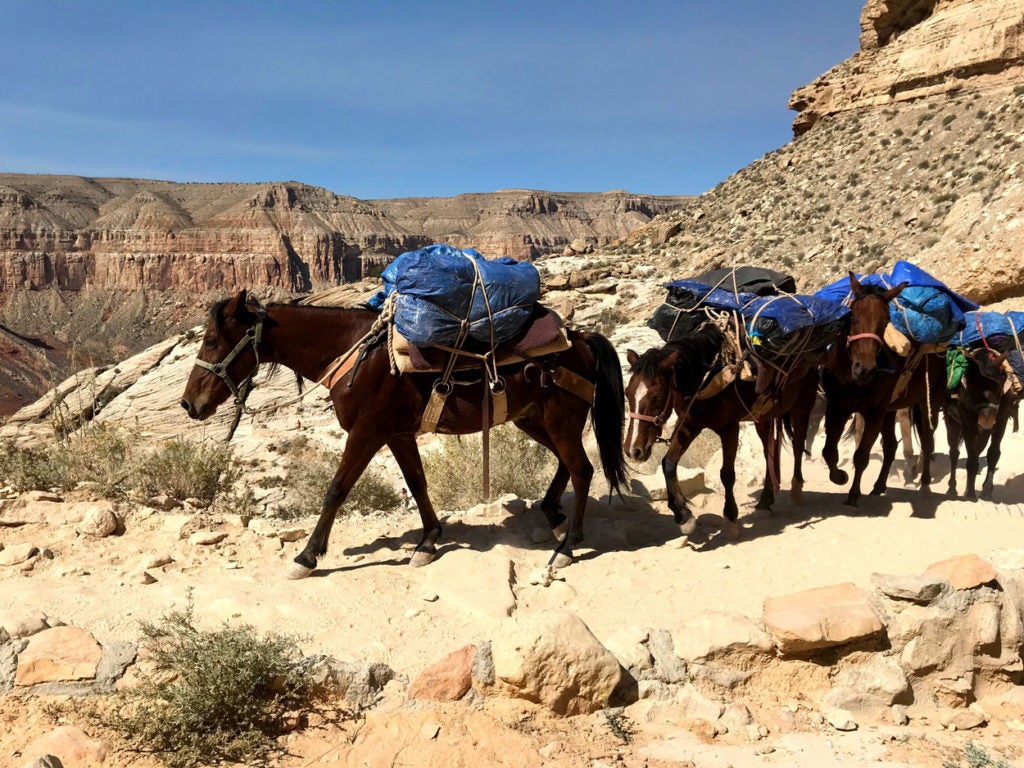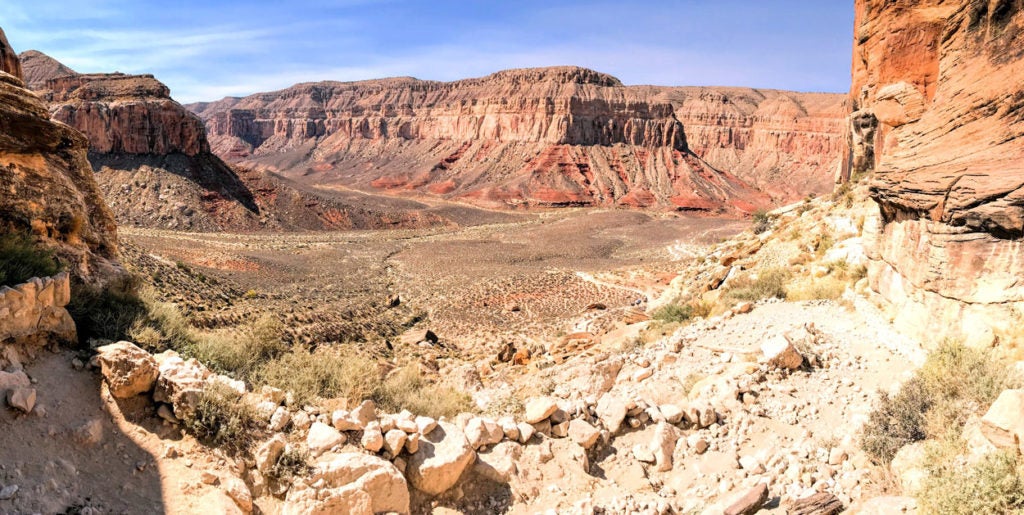In a remote village, deep down in the Grand Canyon, visitors will find one of the world’s most amazing environments.
Havasu Canyon is best known for its stunning waterfalls and breathtaking blue green waters, which attract thousands of tourists every year.
What visitors will also find is a federally run school that is closed much of the time, and parents desperate to give their kids opportunity through education.
During my journey to this magical place, I had the opportunity to speak with children who were strolling through the village of Supai, mid-morning, on a Thursday.
They weren’t on their way to or from school. The Havasupai school was quiet, nestled in the shades of trees, and surrounded by hiking tourists on their way to the Havasu Falls campground.
There was no sign of class taking place. No sign of any life in the school’s building or courtyard.
Havasupai Elementary School was completely empty. (Photo: Romina Boccia)
I asked a couple of young girls who were perhaps 7 or 8 years old if they had had school today. They giggled and said: “Yes, we had school. But we didn’t go!” as they hurried across the sandy canyon bottom path.
A mother with three young children was on her way to Havasu Creek where the kids would swim all day. I approached her to speak with her about the school. What she told me made my heart sink.
The school is closed much of the time. Even when it is open, some parents don’t like to send their children to it. Due to the lack of engaging activities, the children have a tendency to act up and be sent home as a result.
They don’t learn much, and they are far behind their grade level in reading, math, and other important subjects. “It’s too late for us. We just want to secure a better opportunity for our children,” she told me.
The Need for an Alternative
Parents in this remote village will go to great lengths to secure whatever little education they can afford to provide for their children.
Supai’s remoteness is exacerbated by the geological features that surround the village. There is no road to Supai.
All persons and goods arrive either on foot or mule, traveling for 8 miles down steep, rocky trails and on the pebbled and sandy floor of the Grand Canyon with little shade to protect you from the grueling summer sun—or by helicopter.
Mules are commonly used for transportation in the rugged canyon terrain. (Photo: Romina Boccia)
There is no other way in or out. Once at the rim of the Grand Canyon, it’s 60 miles to the next village, called Peach Springs.
And yet, parents were telling me that they try to send their kids to the rim for tutoring whenever they can, sometimes twice a week. Given their limited economic resources, they appeal to the tribe for funds to help pay for tutors up on the rim.
The parents I spoke with were unwilling to go on the record. It’s a small community down in Supai, which is inhabited by roughly 450 people.
Parents are struggling to secure their children’s future with a good education, but they are also wary of complaining to outsiders for fear of being ostracized in their village.
“How would you feel if you received a debit card with funds specifically allocated toward your children’s education?” I asked one mother.
“You could choose how to spend them, be it on online education, getting together with other parents and bringing a teacher to the village for a fellowship, or sending your children to the rim for schooling and tutoring.”
Her eyes lit up. “That would be incredible! It would be so helpful,” she said.
What I described to her was the concept of an education savings account. These accounts—currently in law in six states—take a portion of what the state would have spent on a child in a district school, and instead give it directly to parents.
In Arizona, for example, the first state to adopt an education savings account model, parents who choose to exit the district public system receive 90 percent of their child’s state per-pupil funding.
Parents can then use those funds to pay for private school tuition, online learning, special education services and therapies, textbooks, curricular materials, and a host of other education-related services, products, and providers.
They can even roll over unused funds from year to year, saving for future education-related expenses.
In other words, instead of assigning children to government-run schools, and then sending education dollars to those schools with little regard for whether the schools are performing well or meeting the needs of students there, education savings accounts give those funds directly to parents (who are experts in the needs of their own children), and allow them to completely customize their child’s education.
A Local Solution
Education savings accounts are particularly suitable to remote areas like Havasu Canyon.
Parents, empowered with education savings accounts, could bring private tutors or teachers to this beautiful, natural attraction. Parents could hire private tutors for their children, as many families in states with education savings accounts currently do, and as some families in Havasu Canyon are currently struggling to do with limited resources.
They could access online learning courses (Havasu Canyon is internet-connected, and it’s possible we would see entirely new private school options pop up. All this could happen if students in Havasu Canyon are given control of the funding that currently goes to government schools on their behalf.
Education savings accounts are gaining popularity in states across the country, providing thousands of students with control over their educational destines. It’s an option that couldn’t come soon enough for Native American students living in Havasu Canyon and across the country.
A view of Havasu Canyon from the trail. (Photo: Romina Boccia)
The school that now sits on the floor on the Grand Canyon, closed mid-morning on a Thursday, is a federally supported school managed by the Bureau of Indian Education.
Funding for Bureau of Indian Education schools is unique within K-12 education financing because it is almost entirely federal.
In a searing exposé by Politico on such schools, “How Washington Created Some of the Worst Schools in America,” reporter Maggie Severns describes the state of affairs:
The network of schools for Native American children run by an obscure agency of the Interior Department remains arguably the worst school system in the United States, a disgrace the government has known about for eight decades and never successfully reformed. … The 48,000 students unfortunate enough to attend [Bureau of Indian Education] schools have some of the lowest test scores and graduation rates in the country—even as the education they’re getting is among the nation’s most expensive.
Native American children across the country attending Bureau of Indian Education schools are two grade levels behind their Native American peers who attend public schools. Yet Havasupai Elementary School is a particularly poorly performing school.
As The Washington Post’s Emma Brown reported, only two subjects are taught: math and English. There are no social studies classes. No science classes. No art. There is no school library or athletics.
Children are often taught by rotating substitute teachers. There is no mechanism in place for identifying or helping children with special needs. For weeks at a time, the school just shuts down.
Things are so bad that nine Havasupai families have sued the federal government to get the services they are entitled to.
Liberate the Children
Children in Supai—and attending Bureau of Indian Education schools across the country—need an immediate escape hatch.
Instead of funneling $830 million annually into a system of federal Bureau of Indian Education schools, parents should be able to access those funds in the form of an education savings account.
Such a proposal already exists. The Native American Education Opportunity Act, introduced by Sen. John McCain, R-Ariz., would create a system of tribally operated education savings accounts for children at Bureau of Indian Education schools.
These schools have been failing Native American children for decades. The children who are unable to go to school during the day at Havasupai Elementary know that firsthand. Even when the school doors are open, what goes on in the classroom is far from education.
It’s time to unlock educational opportunity for these children and students assigned to Bureau of Indian Education schools across the country, and empower families with education savings accounts.
This piece originally appeared in The Daily Signal







